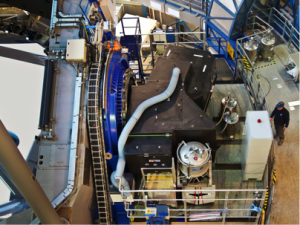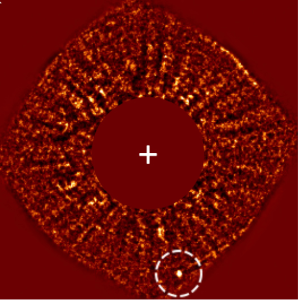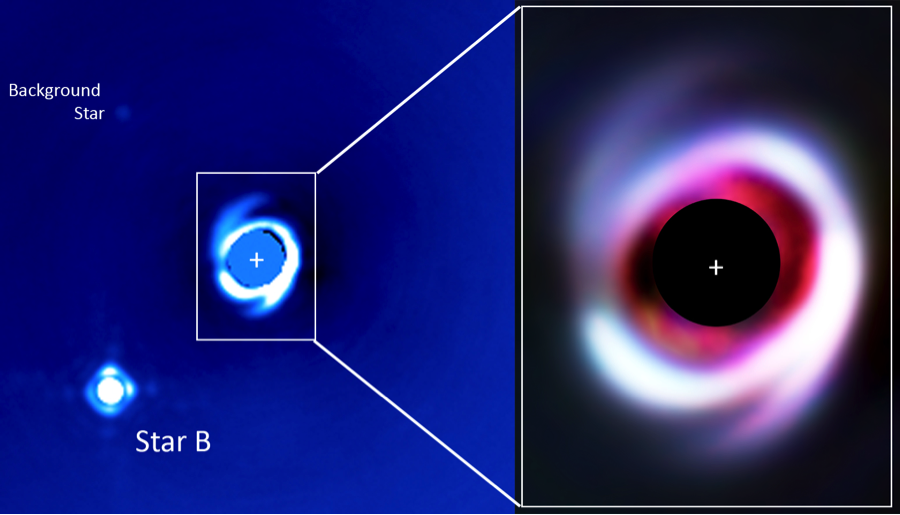By Kevin Wagner
Searching for planets outside of our own solar system is one of the great challenges in modern astronomy. The problem consists of measuring the brightness of a planet that is more than a million times fainter than its host star, while being so close to the star that even to the world’s largest telescopes the two appear as one due to the blurring of the Earth’s atmosphere – akin to trying to detect a firefly next to a lighthouse from over 1,000 miles away. The observational techniques and technology are finally at a point where we are beginning to overcome these challenges and have been able to take astonishing photographs of alien worlds. The first few planets to have been discovered are of course the easiest observational targets: giant gaseous planets, 2-10 times as massive as Jupiter, at large separation from their stars. While the discovery and characterization of these worlds is fueling current exoplanet science, the instrumentation development trend continues to push toward the more challenging prospect of imaging Earth-like planets that are yet fainter and closer to their stars.

The four 8.2 meter telescopes that comprise the Very Large Telescope (VLT) in Chile’s Atacama Desert.
The spring before I started in the Astronomy Ph.D. program at University of Arizona, my advisor, Dr. Daniel Apai, flew me from my hometown in Kentucky to Tucson in order to begin working as soon as possible on a very exciting project. He had secured about a week of time on the 8.2 meter Very Large Telescope in the Atacama Desert of Chile, using a new instrument called SPHERE (the Spectro- Polarimetric- High-Contrast- Exoplanet- Research instrument), which was designed specifically to image planets around other stars. The instrument addresses the problems of contrast and atmospheric blurring by 1) using a coronagraph, which is essentially a mask designed to block out as much of the starlight as possible, and 2) with the use of adaptive optics (AO), i.e. a rapidly deformable mirror, to very accurately correct for the blurring due to the Earth’s atmosphere so that the starlight and planet light may be separately resolved. SPHERE isn’t the first AO/coronagraphic facility on an 8-m class telescope, but it is of the first generation of “extreme-AO” systems, which use much faster and more precisely deformable optics than the previous instruments, and are anticipated to discover dozens of new worlds down to Jupiter mass planets over the coming years. Our team in particular is looking at around 100 young stars near the constellation of Scorpius, with the goal of searching a very young population of stars (less than 1% as old as our sun) to get around the fact that planets grow fainter as they get older and cool down.

SPHERE, the grand-piano sized box of planet finding instruments, installed on one of the VLT unit telescopes, with a human for scale.
Unlike Ben and Min (see previous post), a large percentage of modern astronomy is done in “queue-mode” – where the scenario plays out as follows:
- The astronomer writes a proposal to an observatory detailing a science case and observing strategy
- If allocated time, the staff at the observatory carry out the observations
- The data is sent back to the astronomer, who then proceeds as normal with data reduction and analysis.
Almost everybody agrees that this way is less fun (who doesn’t love changing spectrograph gratings on their own), but the queue-mode ensures that important observations are carried out in good conditions, whereas classical observing is at the mercy of the weather on the scheduled nights of telescope time. It also permits the astronomer the surreal experience of exploring outer space from their basement, which is how I made the discovery that was the first surprising result of the survey.

An example of an extrasolar giant planet candidate imaged by VLT/SPHERE, with the particular world in this example being roughly 2-3 times as massive as Jupiter, but less than 1% as old, and curiously orbiting seventeen times further out.
Many young stars are encircled by disks of gas and dust – primordial building blocks of planet formation that are left-over from the birth of the star. Imaging these disks allows astronomers to investigate by eye for signs of planet formation – to provide tests, constraints, and perhaps new insights to how planets form. As I described above, our science goal was originally to search for these planets themselves, so it came as a surprise to everybody on the team when our images showed the presence of a beautiful spiral disk around the young star HD 100453. The disk was actually already known to reside around the star from the amount of infrared light it emits. But with many imaging campaigns succeeding at imaging only a small fraction of known disks, including failed previous attempts around this same star, the reality of having these beautiful spiral arms show up unexpected is an example of the universe turning out to be more wonderful than we had imagined – something that observational astronomers are continuously witness to.
Through an excellent agreement with dynamical computer modeling, a subsequent study at UC Berkeley found that the spiral arms are driven by the 0.3 solar mass dwarf star at 120 AU. The spirals in this disk are the third of their kind to be observed in young stellar disks, yet the only case where the perturbing companion has successfully been imaged – suggesting that the other two systems are caused by smaller, planetary mass companions, which are current targets for the extreme-AO imaging systems. In addition to the spiral arms, the disk shows compelling evidence for a forming planetary system within, through the presence of large gap in the surface density, seen as the central red region in the image shown here. These gaps have long been regarded as evidence of gravitational sculpting by forming planets, and astronomers have just recently started to find the planets that were expected to be hiding within (see the discovery of two protoplanets in the disk gap in LkCa 15). The gap in HD 100453 extends just barely outside of the coronagraph on SPHERE, which excitingly suggests the presence of forming planets that will just have to wait for future missions that will be able to look in close enough to find them.

The spiral disk in HD 100453 revealed by VLT/SPHERE: The wide-field image on the left displays the disk in K-band (near-infrared) scattered light, and shows the binary star HD 100453B (labeled “Star B that is driving the spiral structure. On the right, the disk is displayed as seen by SPHERE’s integral field spectrograph (IFS), which obtains a multi-color image of its smaller field of view. The difference in the color of the structures is not presently well understood.
For more about this work, please see our HD 100453 Spiral Discovery Paper: Wagner et al. 2015, Astrophysical Journal Letters, http://arxiv.org/abs/1510.02212
And our paper detailing the discovery of an edge-on debris disk in HD 110058: Kasper et al. 2015, Astrophysical Journal Letters, http://arxiv.org/abs/1510.02210
More results from the rest of the survey coming soon!
